A Gallery of Works
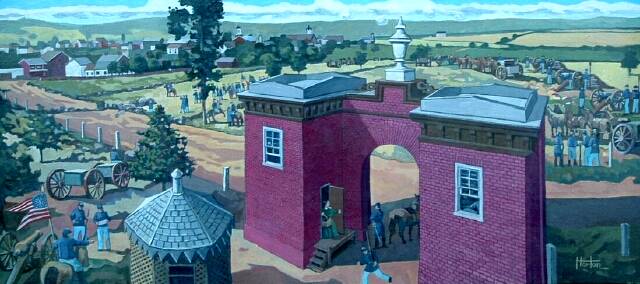
The Gatehouse on Cemetery Hill
NFS prints available
The Evergreen Cemetery Gatehouse on Cemetery Hill as it appeared at the time of the Battle at Gettysburg.
The union army retreated to this position after being outmatched during the first day of the battle.
Elizabeth Thorn lived at the gatehouse and helped the soldiers, tending to the wounded and baking bread,
before leaving for safer environs. The hill was soon to be engulfed in a death struggle with Confederate General
Richard Ewell for control and the key to victory.
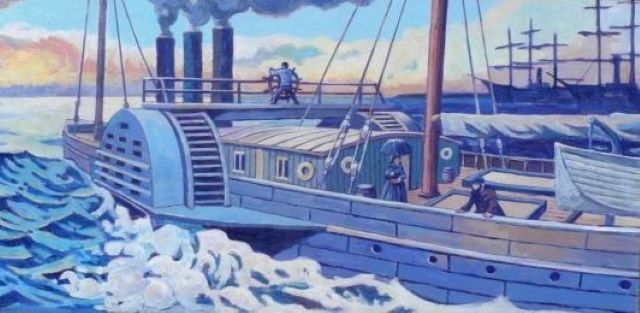
NFS prints available
Blockade Runners routinely transported goods and people past the Union Naval Blockade using their stealth and speed. This Blockade Runner,
The Condor carried a very special passenger, Rose O'Neal Greenhow, a notorious Conferderate spy who had been in hiding in England. Greenhow
carried around her neck a sack which contained $2000 in gold and some say communications for Jefferson Davis, The Condor ran aground
in a storm off the coast of North Carolina. Greenhow, fearing capture climbed into a lifeboat which capsized in the water. The heavy
sack of gold pulled her under and her body washed ashore near Fort Fisher. Her body laid in state in Wilmington NC and she received a
hero's funeral.
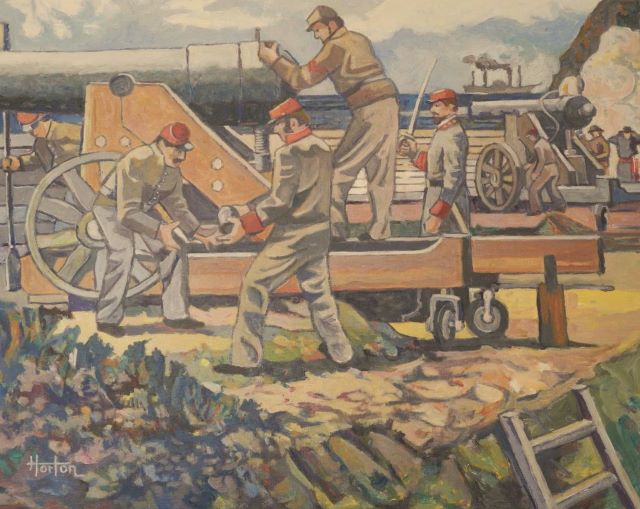
Oil on Canvas Board $500 prints available
Fort Fisher in North Carolina guarded The Inlet to Wilmington NC. The Union Blockade was always offshore to prevent Blockade Runners from bringing supplies to the Confederacy. Colonel William Lamb directed construction of this massive fort and is shown overseeing a gun crew as it loads a projectile into the 32 Pounder Artillery piece. A Blockade Runner can be seen as it makes it's way to the New Inlet under cover of protection from these cannons.
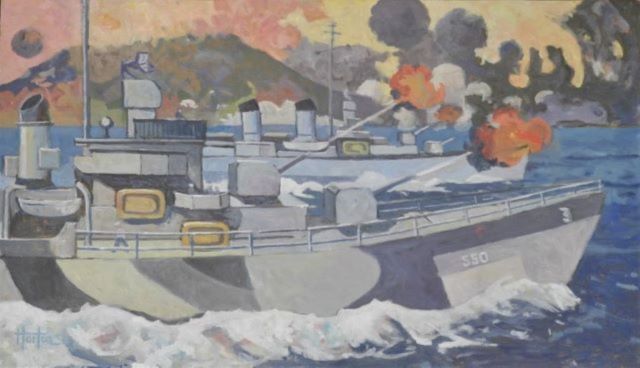
NFS prints available
The USS Capps was a Fletcher Class Destroyer that served in the Atlantic and Pacific during World War II. The Capps was on the firing line at the Battle of Iwo Jima in the shadow of Mount Surabachi. Surabachi was the sight of the famous photo of Raising the Flag at Iwo Jima
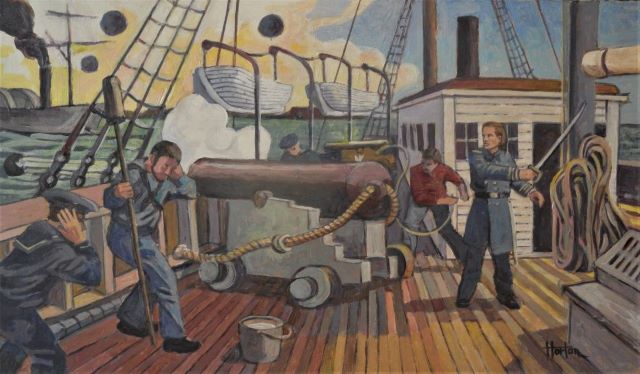
$495.00prints available
Commander William Cushing of the USS Monticello was just 22 years old when he received praise and awards for his feats of bravery in seemingly suicide missions. Cushing was heavily involved in actions in Northy Carolina and the battles at Fort Fisher and Fort Anderson.
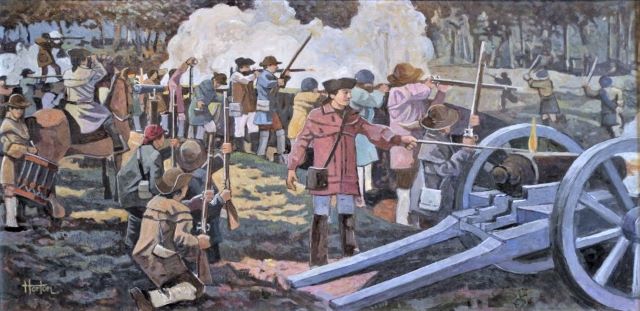
The Battle of Moores Creek Bridge
$825.00 prints available
The Battle of Moores Creek Bridge was Revolutionary War battle in North Carolina. The battle occurred in February of 1776 with Patriots from North Carolina against Loyalists, many from Scotland and armrd with only Broadswords. The Loyalists were trying to get to the North Carolina coast to redevous with the British army and be suppled for war against the Patriots but were turned back at Moores Creek Bridge an army of militia under the command of Colonel Richard Caswell and the cannons "Mother Covington" and a smaller swivel cannon. It was a complete victory by the Patriots and solidified North Carolina's place in the Revolutionary cause.
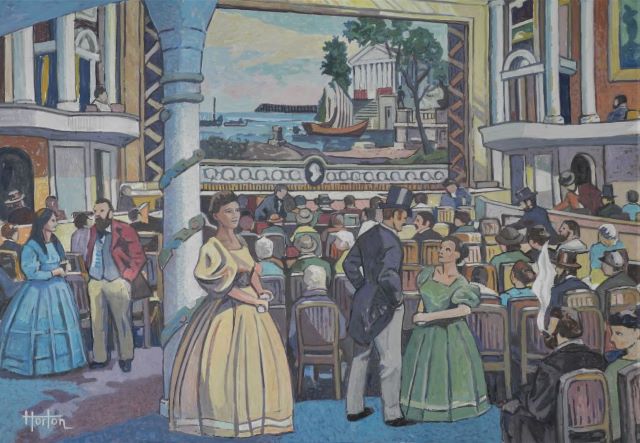
$695.00
The Thalion Hall Opened in Wilmington North Carolina in 1858. The Curtain was hand painted by a well known artist and hung in the theatre until 1909. Famous actors of the 19th Century and the 20th Century played in this great Hall and their photos can be scene throughout it.Although a lot has changed in the theatre over time it still retains much of it's Antebellum design. The theatre Is still in use and the curtain can still be seen in it's lobby, one of the earliest surviving relics of it's kind.
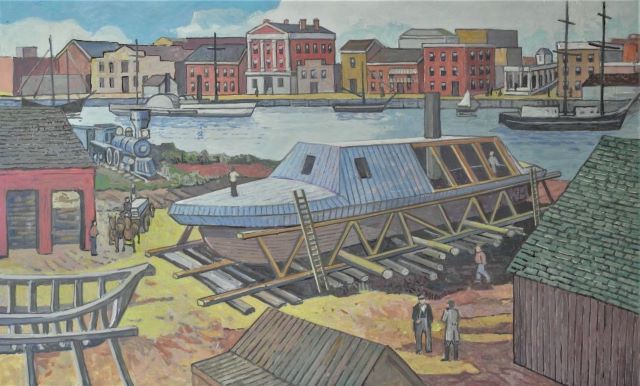
$525.00 prints available
Beerys Shipyard built warships for the Confederate Navy and beyond. It was located accross the river from Wilmington North Carolina. This painting shows the construction of the CSS North Carolina, an Ironclad that eventually ran aground on the Cape Fear River. Civil War era Wilmington is in the background.
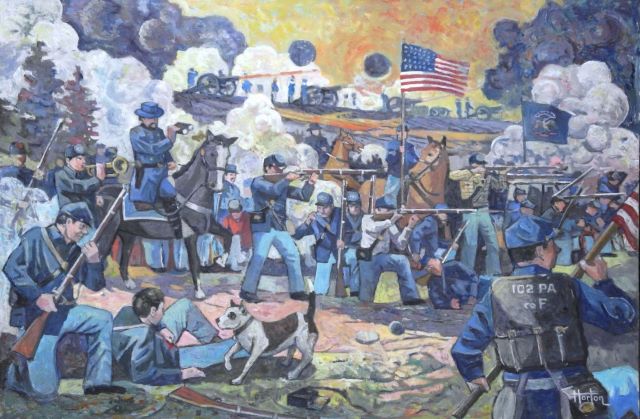
Dog Jack and the 102nd Pennsylvania
Prints available
The 102nd Pennsylvania Civil War Regiment had a mascot. It was a Bull Terrior named Jack. Better known as Dog Jack, he accompanied the regiment in all of it's battles being wounded at this Battle of Malvern Hill. Jack stood faithfully by it's wounded soldiers and on an occasion when he was captured prisoner along with other soldiers, The Union Army traded a Confederate prisoner for Jack. Jack went missing in late 1864 and his fate is unknown.
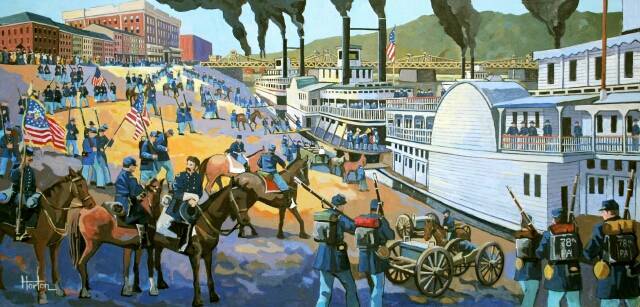
NFS prints available
The Negley Brigade was a brigade of regiments from central and western Pennsylvania during the the Civil war. It's
commander, General James Scott Negley of East Liberty in Pittsburgh along with the 77th, 78th and 79th Pennsylvania
regiments,left Pittsburgh at the Monongahela wharf in October of 1861 as depicted in this painting.Unlike most regiments
from Pennsylvania, these men fought in battles in the west including Shiloh, Stones River, Chickamauga and Chattanooga.
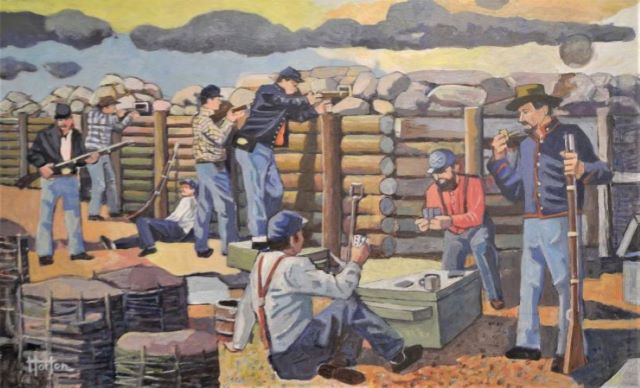
NFS prints available
During the Civil War,at Petersburg, both the Union and Confederate armies were ensconsed in formidable trenches some just 50 yards from each other. These 18th Corp soldiers were used as sharpshooters to shoot at anyone whose head appeared above the sandbags. other soldiers played cards in between sharpshooter duties as depicted in this Acrylic painting.
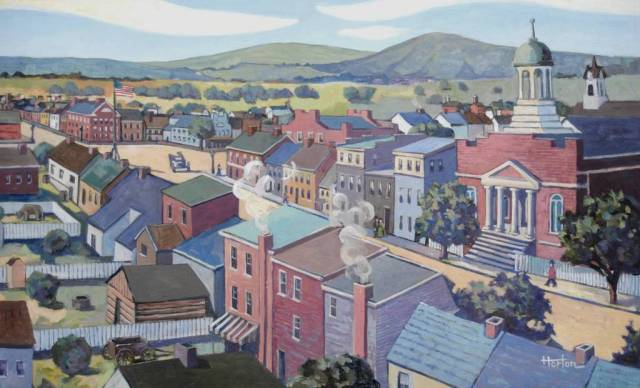
Chambersburg Street circa 1863
$200.00
After the first day of The battle of Gettysburg, the Union army retreated through town and down this street taking shelter
in many of these buildings. The Christ Lutheran Church shown here is still standing along with some others. Chaplain Horatio Howell of the 90th PA was killed by a rebel sharpshooter as he stood on the steps of the church after caring for wounded.
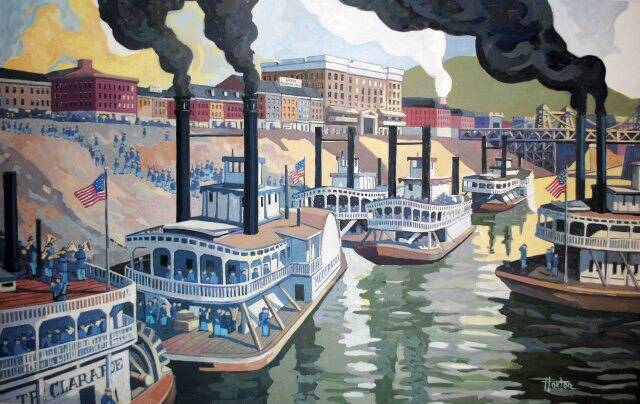
prints available
This is a painting of the Monongahela Wharf in Pittsburgh PA as it appeared in 1861. The painting shows
The Negley Brigade as they embarked onto steamboats that went down the Ohio River to Kentucky, where they
were put into service with The Army of the Ohio during the Civil War. The Brigade consisted of soldiers from
the 77th, 78th and 79th Pennsylvania and served under General James Negley from Pittsburgh PA. This view of
Pittsburgh was last time many of these soldiers would see of the city. Also shown on the painting is the Monongahela House,
a popular hotel in the 19th century and welcomed among it's guests Abraham Lincoln, who stayed there on his way to
Washington for his Innauguration. Also note the bridge that stood there at time. It was an early suspension bridge and was
designed by James Roebling, who went on to engineer The Brooklyn Bridge.
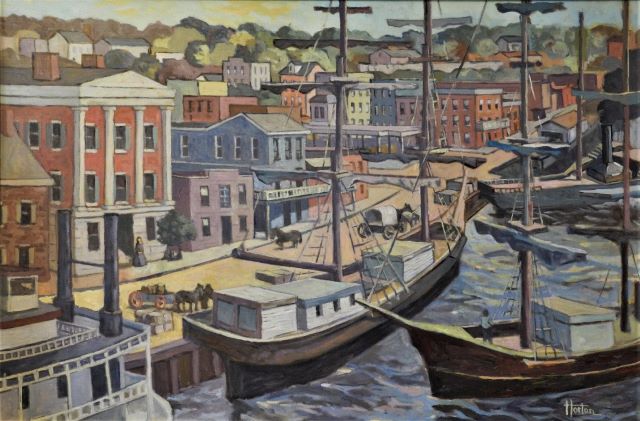
$525.00
The waterfront of Wilmington, NC was teaming with activity during the Civil War. Wilmington was the last port that the Confederacy had to import and export goods, the others having fell into Union hands. The red columned building in the foreground was The Customs House and stood until 1917. Different types of ships are shown on this painting, the Cape Fear River being filled with ships coming in and out.

The 2nd Pennsylvania Heavy Artillery
NFS prints available
This regiment manned the Defenses of Washington for most of the war.When General Grant took over the Army in 1864,
these soldiers were pulled out of the forts and sent into combat. They were an important part of the final year of the war
and were in continual service during the seige of Petersburg.
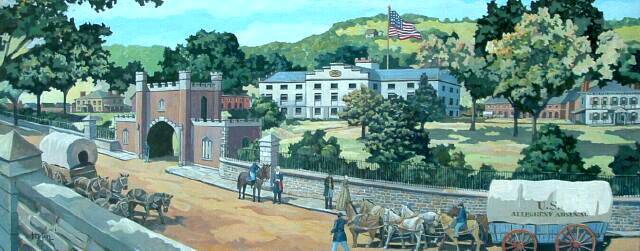
The U.S. Allegheny Arsenal NFS prints available
The U.S. Allegheny Arsenal was located in the Pittsburgh community of Lawrenceville and made ammunition
and other items during the Civil War. On September 17, 1862, an explosion at the site took the lives
of scores of workers, mostly young girls. There were accusations against the commander of the facility
but it was concluded that the explosion was most likely a tragic accident.
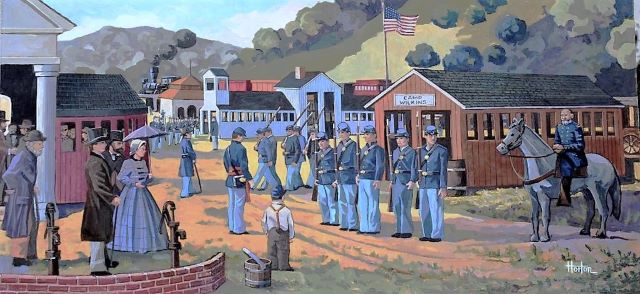
prints available
Camp Wilkins was the first Civil War Camp in Pittsburgh. Located on Liberty Avenue on the present day Strip District, it occupied the Allegheny County Fairground buildings. Phoann Jarret was the Commander of the camp and on weekends, families were allowed to attend and watch their friends and family in drills. The camp did not last long when soldiers, getting into fights and trouble in the city required a new camp farther up the river.
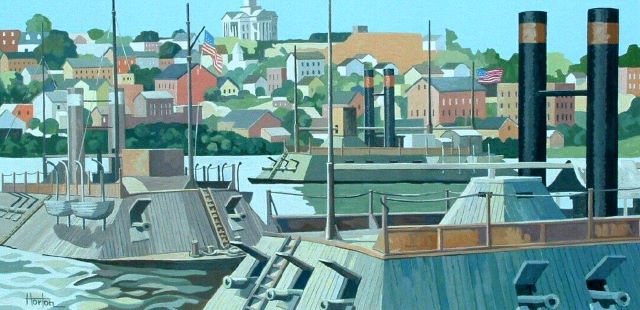
At The Banks of Vicksburg 24" X 11" $575.00
The seige of Vicksburg brought forth the full might of Grants Army in the West. The Union Gunboats
shown include the U.S.S. Pittsburgh, U.S. Benton, and U.S.S. Mound City.
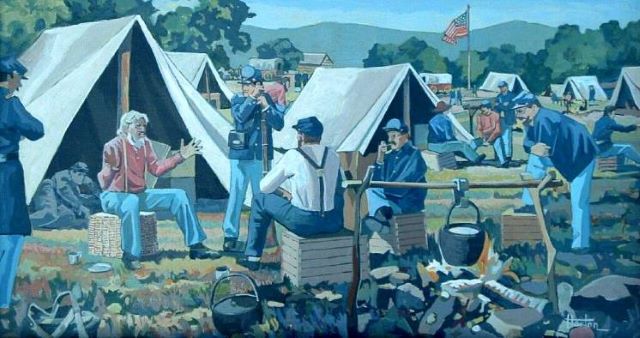
The Old Veteran 20" X 10" $575.00
This is an imagined scene of an old veteran captivating young soldiers at camp with tales from past
campaigns.

Brady's Rangers 36" X 24" $675.00
Sam Brady was a hero of his time as he patroled the rivers and rugged frontiers of Western PA and Ohio, in search and rescue of captured men, women and children. Brady and his Rangers were considered an elite force and worked out of Fort Pitt and Fort McIntosh in the time of the American Revolution. This picture represents Sam and his Rangers as they return to Fort Pitt after a successful rescue mission